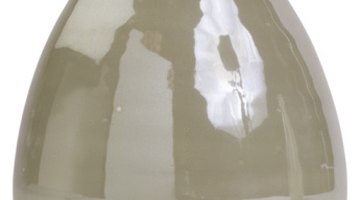How to Seal a Leaky Ceramic Vase
A professionally crafted ceramic vase is typically leakproof, but minor flaws can lead to pinhole cracks and fissures. Mishandling or accidental damage can also cause leaks, particularly in unglazed ceramic or clay vases. Sealing the vase with an acrylic sealant product ensures that water stays inside where it belongs.

Things You Will Need
- Ceramic cleaner
- Soft cloth
- Acrylic floor sealant
Tip
Acrylic floor sealant does not work on air-dry/oven-baked clay vases.
Warning
If the vase still leaks after four layers of sealant, there is likely a flaw that’s too great to be fixed with sealing, The vase can therefore not be used to hold liquids.
Never apply acrylic sealant to dinnerware; use this process only on ceramic vases not intended for food use.
-
Clean the vase with a ceramic cleaner and a soft cloth to remove any dirt from the surface that could interfere with the sealing process. Place the vase onto a level work surface.
-
Pour a small pool of acrylic floor sealant onto a piece of cloth. Spread the sealant over the outer surface of the vase with the cloth, taking care to cover the entire vase with the material. Allow the sealant to dry on the vase overnight.
-
Apply a second coat of sealant to the outside of the vase to augment the first, ensuring that no portion of the vase goes unsealed. Allow an additional 48 hours of drying time before placing any liquid into the vase.
-
Fill the vase with water and examine the surface for signs of leakage. Allow the water to sit inside the vase for 24 hours, checking occasionally for signs of leaking. If leaks occur, empty the vase, dry it off and apply two additional layers of sealant, following the same steps used for the first two layers. Repeat the test to make certain the vase is completely sealed, then use the vase as normal.
The Drip Cap
- A professionally crafted ceramic vase is typically leakproof, but minor flaws can lead to pinhole cracks and fissures.
- Allow the sealant to dry on the vase overnight.
- Apply a second coat of sealant to the outside of the vase to augment the first, ensuring that no portion of the vase goes unsealed.
Resources
Writer Bio
Larry Simmons is a freelance writer and expert in the fusion of computer technology and business. He has a B.S. in economics, an M.S. in information systems, an M.S. in communications technology, as well as significant work towards an M.B.A. in finance. He's published several hundred articles with Demand Studios.
Photo Credits
- Hemera Technologies/PhotoObjects.net/Getty Images
- Hemera Technologies/PhotoObjects.net/Getty Images
More Articles



